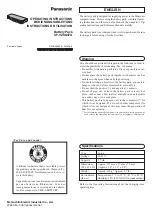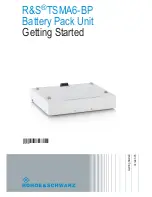
Troubleshooting Guide
6
31039B
NECESSARY TO USE THE CHARGER ON A
DIFFERENT SET OF BATTERIES AND THE
ORIGINAL SET OF BATTERIES ON ANOTHER
CHARGER.
Part A Charger turns off too soon
Check to be sure the power supply cord is securely
connected to a live outlet. If the power supply outlet
is live, proceed with the next step.
To determine if the charger did shut off too soon,
disconnect and reconnect the charger DC output
connector. This will restart the charger. Observe
charger output on the ammeter.
1.
The ammeter needle jumps smartly to between
20 and 25 amps and then tapers below 14 amps
within 15 minutes. This indicates that the
batteries were truly charged. The apparent
short charging time is in response to the
batteries' ability to accept charge and the
electronic timer is performing properly.
2.
The ammeter needle jumps smartly to between
20 and 25 amps, but does not taper below 14
amps within 15 minutes. If the batteries have
been properly maintained and charged regularly,
this generally indicates that the batteries were
not fully charged. If possible, use a hydrometer
to check the specific gravity of several battery
cells. If the specific gravity readings are more
than 30 points (.030) lower than normal full
charge readings, the electronic timer has
malfunctioned and the complete Electronic
Timer Kit must be replaced. Refer to Section 1,
Part D, "Electronic Timer Replacement", for
correct procedure.
If the batteries have not been used or charged
regularly, they may be sulfated and will not
produce their full capacity. Repeated cycles (at
least 5) of a light discharge, followed by a full
charge, will generally result in the recovery of
most of the battery's capacity. Do not interpret
this reduced battery capacity as being caused
by the charger's turning off too soon. The
charger is working properly if, after several
charge cycles, the battery capacity increases to
near normal. Sulfation occurs most often when
the batteries have been stored without weekly
charging. New batteries may also be sulfated
due to extended shipment or storage time prior
to sale.
As batteries age, individual cells may weaken,
causing a reduction in battery capacity. This
condition normally results in a finish charge rate
higher than 10 amps and less time is required to
fully charge the batteries. Do not interpret this
shorter charging time and reduced battery
capacity as being caused by the charger's
turning off too soon. The battery is aging
naturally and the charger is working properly.
When the batteries will not longer perform as
required, they should be replaced.
Part B Charger does not turn off
New batteries with all good cells should rise to at
least 2.5 volts per cell. This will allow the finish
charge rate to taper below 8 amperes. As batteries
age, individual cells may weaken and these cells
may not reach 2.5 volts. This will result in finish
charge rates greater than 8 amperes, and less time
will be required for the batteries to reach full charge.
At a finish charge rate of 8 amperes or less, the
charge time should not exceed 18 hours. At a finish
charge rate greater than 8 amperes, the charge time
should not exceed 14 hours.
If the charger remains on longer than the specified
maximum time, check to see if the charger turns on
immediately when the DC output cord is connected
without the normal two to five (2-5) second delay. If
the charger turns on instantly without the 2-5 second
delay, the Electronic Timer Kit has probably failed.
This type of malfunction generally results in the
charger not turning off and the complete Electronic
Timer Kit must be replaced. Refer to Section 1, Part
D, "Electronic Timer Kit Replacement", for correct
procedures.
If the charger remains on longer than the maximum
time specified and the two to five (2-5) second delay
is present, verify that the GREEN wire from the
Electronic Timer Kit and the secondary transformer
coil lead are securely connected to the diode lead.
(Not all Electronic Timer Kits will have a GREEN
wire.) The charger will NOT turn off if the GREEN
wire is loose or disconnected. If the GREEN wire is
securely connected, the Electronic Timer Kit has
malfunctioned and the complete Electronic Timer Kit
must be replaced.
If a precision digital type DC voltmeter is available, a
test to verify that the Electronic Timer has
malfunctioned can be made. Connect the charger to
the batteries and allow to charge normally. After the
charge rate has tapered to its lowest point, measure
the battery terminal voltage using a DC voltmeter
capable of reading in increments of .001 volts.
Continue charging and check the battery voltage
reading every hour. If the battery voltage increases
less than .012 volts, or if the battery voltage
decreases between successive hourly readings, the
charger should turn off. If the charger does not turn
off, the Electronic Timer has malfunctioned and the
complete Electronic Timer Kit must be replaced.
Part C Charger runs too long but does turn
off
In the event of AC power interruption when the
charger is on, the charger will automatically restart
when AC power is restored. This power outage can
make the apparent charge time seem longer than
the actual charge time. To check for AC power


























